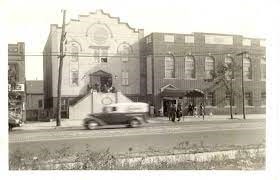Personal Recollection of Rose Chernow-O'Leary
Our March 2022 Monthly Memoir is based on the recollection of Rose Chernow-O'leary. It was adapted from the Bayonne Community News and from an undated article by Al Sullivan. Rose earned her Ph.D. from Columbia University's Teacher's College. She belonged to Congregation Ohab Sholem in Bayonne as did her parents and grandparents.
A Personal Recollection - I thought membership at Ohab Sholem was one of the most important foundational experiences in my life after I had recently returned to Bayonne to peek into the temple. I noted that one the windows in the temple memorializes my grandparents because it was common practice to have windows honoring members. I would have loved to purchase that window if the opportunity had come about.
My parents owned Chernow’s Hardware at 50th Street and Broadway for over 60 years. My grandparents came from the Odessa area and eastern Europe. Russians were very big in shul. Many of those who founded the shul had come to America fleeing oppression. The Russian Czar was conscripting men and slaughtering Jewish people throughout Russia.
Jews came here to escape. My grandparents were among them. Most of them knew persecution well before the Holocaust. My grandmother’s grandmother was in Russia when the Cossacks came. The congregation was founded in 1916 although the temple was not constructed until 1925. The temple closed its doors in 2003 due to the shrinking Jewish population in Bayonne. The property was sold and the members of the congregation voted to donate the proceeds to various good works.
The Uptown Synagogue became the symbol of hope that translated in later generations like mine and became a special place for growing up. It was the very center of our community. Although I have not returned to the synagogue in years I remember the Zodiac painted in turquoise blue on the ceiling. Because this was an Orthodox temple, women sat in seats separated from the men seated below. A curtain, called a Machetza, kept the women and men from seeing each other.
People usually sat in the same seats for each service. We sat in a corner at the left-hand side. I remember seeing my grandfather, father, and all the men praying. That temple is a luminous place in my mind. For high holidays, we would dress up in our best clothes. Women wore furs, even if it was hot. On days of fasting like Yom Kippur, elderly women would bring smelling salts so they wouldn’t faint. To this day, I recall those moments as special and grand. Though time has brought about a different sensibility as far as the liberation of women, I feel tenderness for that time. I recall that Rabbi Bendelstein and his wife were both leaders in the community. Although the men dominated the rituals, men and women were active. I also remember Cantor Silverstein. When he sang, he would tear your heart out. Some of his prayers sounded like crying and you knew he was praying from out of the depths of his being.
I call the temple “a living and breathing place” and say that life back then was rich with tradition, ritual, and a sense of belonging. I left that life in 1960 when I went off to college. While I returned regularly for several years, especially around the high holidays, that special time in my life had passed. For additional information about our former synagogue please check the following website.

This is a caption
